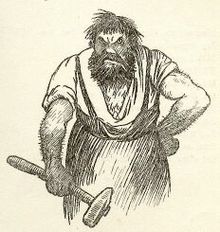Metalsmith

A metalsmith or simply smith is a craftsman fashioning useful items (for example, tools, kitchenware, tableware, jewellery and weapons) out of various metals. [1] Smithing is one of the oldest metalworking occupations. Shaping metal with a hammer (forging) is the archetypical component of smithing. Often the hammering is done while the metal is hot, having been heated in a forge. Smithing can also involve the other aspects of metalworking, such as refining metals from their ores (traditionally done by smelting), casting it into shapes (founding), and filing to shape and size.
The prevalence of metalworking in the culture of recent centuries has led Smith and its equivalents in various languages (German Schmidt, French Lefèvre, Spanish Herrero, etc.) to be a common occupational surname. As a suffix, -smith connotes a meaning of a specialized craftsman—for example, wordsmith and tunesmith are nouns synonymous with writer or songwriter, respectively.
History
In pre-industrialized times, smiths held high or special social standing since they supplied the metal tools needed for farming (especially the plough) and warfare. This was especially true in some West African cultures.
Types of smiths
A metalsmith is one who works with or has the knowledge and the capacity of working with "all" metals.

Types of smiths include:[2]
- An arrowsmith forges arrow heads for the fletcher (an arrow-maker)
- A blacksmith works with iron and steel (this is what is usually meant when referring just to "smith")[3]
- A bladesmith forges knives, swords, and other blades[4]
- A brassfounder works with brass
- A coinsmith works strictly with coins and currency
- A coppersmith (also known as brownsmith) works with copper[5]
- A fendersmith makes and repairs the metal fender before fireplaces, protecting rugs and furniture in mansions and fine estates, and frequently cares for the fires as well
- A goldsmith works with gold[6]
- A gunsmith builds and repairs firearms[7]
- A locksmith works with locks[8]
- A pewtersmith works with pewter
- A scythesmith forges scythes
- A silversmith, or brightsmith, works with silver[9]
- A swordsmith is a bladesmith who forges only swords
- A tinsmith, tinner, or tinker works with light metal (such as tinware) and can refer to someone who deals in tinware[10]
- A weapon-smith forges weapons like axes, spears, flails, and other weapons[11]
- A whitesmith works with white metal (tin and pewter) and can refer to someone who polishes or finishes the metal rather than forging it[12]
- A zincsmith works, fabricates or builds with zinc in sheet or bar form
Artisans and craftpeople


The ancient traditional tool of the smith is a forge or smithy, which is a furnace designed to allow compressed air (through a bellows) to superheat the inside, allowing for efficient melting, soldering and annealing of metals. Today, this tool is still widely used by blacksmiths as it was traditionally.
The term, metalsmith, often refers to artisans and craftpersons who practice their craft in many different metals, including gold, copper and silver. Jewelers often refer to their craft as metalsmithing, and many universities offer degree programs in metalsmithing, jewelry, enameling and blacksmithing under the auspices of their fine arts programs.[13]
Machinists
Machinists are metalsmiths who produce high-precision parts and tools.[14] The most advanced of these tools, CNC machines, are computer controlled and largely automated.
References
- ^ http://www.merriam-webster.com/dictionary/metalsmith
- ^ John Fuller, Sr., Art of Cop workpersmithing, Astragal Press, 1993 (reprint of original edition, 1894) ISBN 1879335379[page needed]
- ^ http://www.merriam-webster.com/dictionary/blacksmith
- ^ http://www.merriam-webster.com/dictionary/bladesmith
- ^ http://www.merriam-webster.com/dictionary/coppersmith
- ^ http://www.merriam-webster.com/dictionary/goldsmith
- ^ http://www.merriam-webster.com/dictionary/gunsmith
- ^ http://www.merriam-webster.com/dictionary/locksmith
- ^ Rupert Finegold and William Seitz, Silversmithing, Krause Publications, 1983, ISBN 0-8019-7232-9
- ^ http://www.merriam-webster.com/dictionary/tinsmith
- ^ http://www.merriam-webster.com/dictionary/weapon-smith
- ^ http://www.merriam-webster.com/dictionary/whitesmith
- ^ Tim McCreight, Jewelry: Fundamentals of Metalsmithing, Hand Books Press, 1997, ISBN 1-880140-29-2
- ^ http://www.merriam-webster.com/dictionary/machinists
